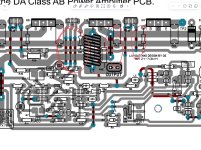Also, post a picture of your board before applying power again. There a lot of eagle eyes on these forums.
I triple checked all devices for continuity to the heat sink before power up. Checked for soldier bridges, nothing.
One thing I have learned over the years. It is very difficult to see your own problems because your mind makes assumptions for you.
When we had stuck techs, I always had someone else look over it (or me). We all have DUH! moments.
When we had stuck techs, I always had someone else look over it (or me). We all have DUH! moments.
Finally got the rest of this beast up and running. Great sounding amp.

That's come a long way MK congrats! If you decide to keep the amp and use it, I would take all the spade and friction connection out and solder them all. In the past, I went in and soldered them with those friction connectors, which works well too. Some will say they will be fine, but when you really want to lock something in, I always solder it.
JT
JT
Hi There-
I have searched and searched, but no luck. It ‘appears’ that there are multiple locations for jumpers (beyond the C-R-Z cascode option. Am I looking at these incorrectly? To illustrate what is confusing me, I circled a few of the areas in question. Thanks in advance,
Wes
I have searched and searched, but no luck. It ‘appears’ that there are multiple locations for jumpers (beyond the C-R-Z cascode option. Am I looking at these incorrectly? To illustrate what is confusing me, I circled a few of the areas in question. Thanks in advance,
Wes
Attachments
Thanks for clarifying! I figured I was missing something. Next time I will try continuity testing prior to populating the pcb.
Wes
Wes
@ Ingo
I do not use speaker protection on any Amp that I build. I have had no need for it and I have had zero problems. I never make any connections with the Amp powered and speaker cables are all in great condition. I tend to think it is a knee jerk reaction that you have to have protection.
I do not use speaker protection on any Amp that I build. I have had no need for it and I have had zero problems. I never make any connections with the Amp powered and speaker cables are all in great condition. I tend to think it is a knee jerk reaction that you have to have protection.
Hi Freecrowder,
As a service technician for nearly 50 years, I'll disagree very strongly with you. I have seen more than my share of amplifiers that destroyed speakers, some causing fires that involved fire departments or fire extinguishers (I did insurance work too). The biggest problems come from amplifiers without active speaker protection. Fuses don't cut it - and they cause distortion.
I'm glad you have never had a problem. But that just like a person that drinks and it's okay because they haven't had an accident or been caught yet. They will argue there isn't a problem - until there is.
The only amplifiers I build without speaker protection are tube amps using output transformers, because DC offset is impossible.
As a service technician for nearly 50 years, I'll disagree very strongly with you. I have seen more than my share of amplifiers that destroyed speakers, some causing fires that involved fire departments or fire extinguishers (I did insurance work too). The biggest problems come from amplifiers without active speaker protection. Fuses don't cut it - and they cause distortion.
I'm glad you have never had a problem. But that just like a person that drinks and it's okay because they haven't had an accident or been caught yet. They will argue there isn't a problem - until there is.
The only amplifiers I build without speaker protection are tube amps using output transformers, because DC offset is impossible.
- Home
- Amplifiers
- Solid State
- diyAB Amp - The "Honey Badger"
